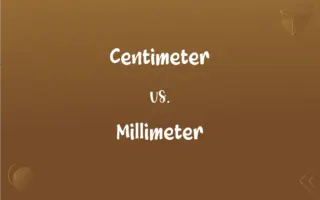Bank Rate vs. Repo Rate: What's the Difference?
Edited by Aimie Carlson || By Harlon Moss || Published on December 5, 2023
Bank rate is the rate at which central banks lend to commercial banks, while the repo rate is the rate at which central banks lend short-term money to commercial banks against securities.

Key Differences
The bank rate is a key interest rate set by a nation's central bank, influencing the cost of borrowing for commercial banks. The repo rate, however, specifically refers to the rate at which the central bank lends short-term funds to commercial banks against collateral.
Bank rates are often used as a tool to control inflation and stabilize the national economy. While, repo rates are more focused on managing liquidity in the banking system, offering a mechanism for banks to secure short-term funding.
Changes in the bank rate can affect the economy broadly, impacting loan and deposit rates. Whereas, repo rate changes typically influence the money supply and short-term interest rates.
Bank rates are generally altered to influence long-term economic trends. In contrast, repo rates are adjusted more frequently to manage day-to-day liquidity.
The bank rate usually has a broader impact on the overall credit conditions in an economy. The repo rate, being a tool for short-term monetary control, has a more immediate but narrower impact.
ADVERTISEMENT
Comparison Chart
Purpose
Influences cost of borrowing for commercial banks
Controls short-term money supply
Impact
Broadly affects the economy and inflation
Affects liquidity and short-term interest rates
Usage Frequency
Altered for long-term economic trends
Adjusted frequently for daily liquidity management
Loan Duration
Typically for longer-term loans
Short-term, usually overnight loans
Collateral
Not necessarily involved
Secured against government securities
ADVERTISEMENT
Bank Rate and Repo Rate Definitions
Bank Rate
Influences long-term borrowing and lending rates.
Mortgage rates are often affected by changes in the bank rate.
Repo Rate
Influences short-term interest rates in the banking system.
Short-term loan rates may drop when the repo rate is reduced.
Bank Rate
A tool for monetary policy to regulate the economy.
The central bank decreased the bank rate to stimulate economic growth.
Repo Rate
A tool for managing daily banking system liquidity.
The central bank lowered the repo rate to increase liquidity.
Bank Rate
The interest rate at which a nation's central bank lends to commercial banks.
When the bank rate increases, commercial banks may raise their lending rates.
Repo Rate
The rate at which the central bank lends short-term money to banks against securities.
An increase in the repo rate can tighten the money supply.
Bank Rate
A benchmark for prime lending rates in the economy.
Loan interest rates often rise following an increase in the bank rate.
Repo Rate
Often adjusted to control inflation and economic stability.
To combat inflation, the central bank raised the repo rate.
Bank Rate
Reflects the cost of borrowing for commercial banks.
Higher bank rates can lead to more expensive loans for consumers.
Repo Rate
Short-term, usually overnight borrowing rate for banks.
Banks often use the repo rate for overnight funding needs.
FAQs
What is the repo rate?
The rate for short-term lending by central banks to commercial banks against securities.
How does the bank rate affect consumers?
It influences the interest rates on loans and savings for consumers.
How often is the bank rate changed?
It’s adjusted based on long-term economic goals.
What's the purpose of the repo rate?
To manage liquidity and control short-term money supply in banking.
Is the repo rate for long-term borrowing?
No, it’s primarily for short-term, often overnight, borrowing.
Is the bank rate the same as the prime rate?
No, but the prime rate is often influenced by the bank rate.
What is the bank rate?
The interest rate at which central banks lend to commercial banks.
What happens when the bank rate increases?
Borrowing costs for banks and ultimately for consumers may rise.
Does the repo rate affect consumer loans directly?
Indirectly, as it influences the overall liquidity in the banking system.
Can the bank rate control inflation?
Yes, by making borrowing more expensive, it can help control inflation.
What economic conditions lead to a bank rate cut?
Slowing economic growth or recessionary trends.
What’s the difference between bank rate and interest rate?
The interest rate is broader, including various rates charged by banks, while the bank rate is specific to central bank lending.
Is the repo rate used internationally?
Yes, it’s a common monetary policy tool worldwide.
How does a change in the bank rate affect the economy?
It can either stimulate or cool down economic activities.
What role does the repo rate play in inflation control?
By influencing the money supply, it can help regulate inflation.
How do banks use the repo rate?
For short-term funding needs, often overnight.
Can the repo rate be negative?
Theoretically yes, but it’s uncommon.
Who sets the bank rate?
The nation’s central bank.
Does the repo rate affect stock markets?
Yes, as it influences the cost of funds for investors.
What collateral is used for the repo rate?
Usually government securities.
About Author
Written by
Harlon MossHarlon is a seasoned quality moderator and accomplished content writer for Difference Wiki. An alumnus of the prestigious University of California, he earned his degree in Computer Science. Leveraging his academic background, Harlon brings a meticulous and informed perspective to his work, ensuring content accuracy and excellence.
Edited by
Aimie CarlsonAimie Carlson, holding a master's degree in English literature, is a fervent English language enthusiast. She lends her writing talents to Difference Wiki, a prominent website that specializes in comparisons, offering readers insightful analyses that both captivate and inform.






































































